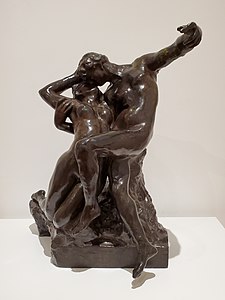| Eternal Springtime | |
|---|---|
| French: L'eternel printemps | |
 Marble version of Eternal Springtime Marble version of Eternal Springtime | |
| Artist | Auguste Rodin |
| Year | 1884 (1884) |
| Type | Sculpture |
| Medium | Marble, bronze |
Eternal Springtime (French: L'Éternel Printemps) is a c. 1884 sculpture by the French artist Auguste Rodin, depicting a pair of lovers. It was created at the same time as The Gates of Hell and originally intended to be part of it. One of its rare 19th-century original casts belongs to the permanent collection of Calouste Gulbenkian Museum. One of its largest marble versions belongs to the National Museum of Decorative Arts in Buenos Aires, Argentina.
Gates of Hell
Rodin originally conceived of Eternal Springtime as part of The Gates of Hell, one of the representations of Paolo Malatesta and Francesca da Polenta, but did not include it there because the happiness expressed by the lovers did not seem appropriate to the theme. The Kiss, another famous sculpture by the artist, shares the same origin, but unlike The Kiss in Eternal Springtime the man dominates the composition, sustaining the arching body of his lover who joins him in a passionate kiss.
Description
Rodin took the woman's torso, with its arched pose, from the Torso of Adele that appears in the upper left corner of the tympanum on The Gates of Hell; the model was Adele Abruzzesi, originally from Italy, and for the man Lou Tellegen. However, at the time of his creation of Eternal Springtime, he was in a romantic relationship with Camille Claudel, and Reine-Marie Paris, the granddaughter of Claudel's brother Paul Claudel, has suggested that traces of Camille can be discerned in the woman of this piece and in other female figures prominent in works Rodin created in the mid-1880s.
Versions
The work was reproduced several times in bronze and marble. A marble version dating to c. 1901 was sold at auction in May 2016 for a then record-breaking $20 million.
One of Rodin’s earliest versions, cast in 1898 by Alexis Rudier's Foundry, which worked directly with Rodin, was bought in 1913 by Calouste Gulbenkian and nowadays is available to public access in his museum. An 1884 version is now on display at the National Museum of Decorative Arts, bought when the palace was a private residence around 1911.
Gallery
-
 Eternal Springtime in marble at the Rodin Museum
Eternal Springtime in marble at the Rodin Museum
-
A bronze copy at the Huntington Museum of Art
-
 Copy at the Philbrook Museum of Art
Copy at the Philbrook Museum of Art
-
 Bronze cast at Museo Soumaya
Bronze cast at Museo Soumaya
-
 Bronze cast at the High Museum of Art
Bronze cast at the High Museum of Art
References
- ^ "La Eterna Primavera". Musée Rodin. Archived from the original on 21 August 2016. Retrieved 9 August 2016.
- Paris, Reine-Marie; Martindale, Meredith (1988). Camille Claudel (exhibition catalogue). Washington, D. C.: National Museum of Women in the Arts. pp. 19, 41. ISBN 9780940979048. Cited in Mathews, Patricia Townley (1999). Passionate Discontent: Creativity, Gender, and French Symbolist Art. Chicago: University of Chicago. p. 254, note 62. ISBN 9780226510187.
- "Rodin marble sells for record $20m at New York auction". BBC News. 10 May 2016. Retrieved 9 August 2016.
External links
 Media related to Eternal Springtime at Wikimedia Commons
Media related to Eternal Springtime at Wikimedia Commons